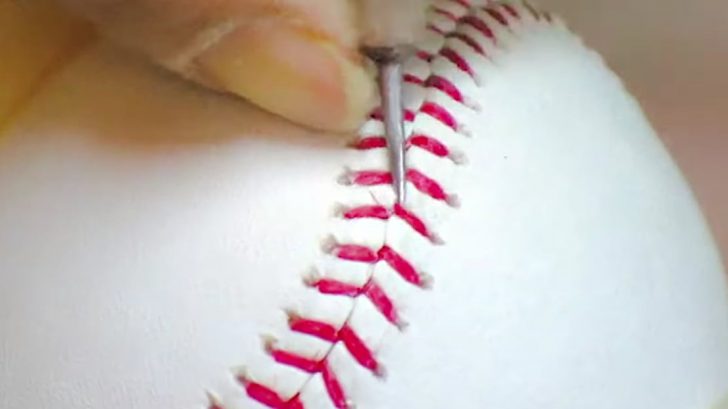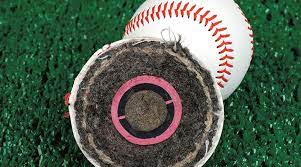The process of making baseballs has evolved over time from using rubber cores from old, melted shoes to the modern techniques employed by manufacturers today. An official Major League Baseball (MLB) starts with a core made of cork mixed with a small amount of rubber, which is then covered by layers of black and red rubber.
Manufacturing baseballs requires extreme attention to detail, in order to ensure consistent performance and quality. They contain a cork center, known as the “pill,” which is wrapped in two thin rubber layers. The pill is then wrapped with multiple layers of wool and poly-wool blend yarn to achieve a uniform shape and weight. This meticulous process is essential for creating baseballs that meet the stringent standards of the MLB.
Throughout the history of baseball, the materials and techniques used to make the ball have changed significantly, yet the passion for the sport has remained constant. The creation of a baseball is a fascinating blend of tradition and innovation, reflecting the ongoing evolution of America’s national pastime.
Contents
History of Baseballs
The history of baseballs dates back to the early days of the sport when balls were often created from rubber cores derived from old, melted shoes, wrapped in yarn and leather. In some places, fish eyes were even used as cores for baseballs. Pitchers typically made their own balls, which would soften and come unraveled as the game went on.
As the sport became more organized in the 1850s, meetings were held periodically between teams and governing bodies to decide on the best weight, dimension, and construction of baseballs. In 1854, three New York teams agreed to use balls that weighed between 5½ to 6 ounces.
The modern baseball design is often credited to Ellis Drake, a shoemaker’s son, who used his father’s scrap leather to create a more consistent and standardized ball.
Throughout the history of baseball, the manufacturing process of baseballs has evolved significantly. Today, the official Major League Baseball (MLB) balls are made by Rawlings, a company that has been the official supplier for 40 years. The modern baseball consists of a cushioned cork center wrapped in layers of yarn and covered with a leather casing, ensuring consistent performance and durability throughout each game.
Materials Used
Core
The core of a baseball, also known as the “pill”, is an essential component that defines the ball’s shape, weight, and performance. Typically, the core is made from a round cushioned cork, which provides the ball with its bounce and resilience. This cushioned cork is then wrapped in two layers of rubber, further enhancing the ball’s durability and structure.
Winding
Once the core is prepared, it is tightly wound with layers of wool and polyester/cotton yarn. This winding process helps to maintain the ball’s shape, while giving it a firm surface that allows for better gripping and performance. A machine is often used to wind the yarn even tighter around the core, ensuring a consistent and solid structure.
Leather Covering
A baseball’s exterior is made from cowhide, providing a durable surface that can withstand the intense impacts and abrasions commonly encountered during gameplay. The cover is either made from white natural horsehide or cowhide or a synthetic composite leather. The leather is tanned and processed into the desired shape, which involves significant usage of water, energy, and the production of hazardous waste.
Stitching
After the core has been wound and the leather covering is prepared, the two halves of the cover are stitched together to form a complete baseball. This stitching not only holds the ball together but also provides texture and grip for the players. Approximately 108 double stitches are used to join the leather covering, using a particular pattern to ensure that the ball retains its shape and even surface throughout its use.
Manufacturing Process
Creating the Core
The process begins by cutting cork into small pieces and heating it until it becomes soft enough to be molded into shape. The molded cork is then placed in a metal mold, giving it a spherical shape. Finally, rubber is injected into the mold, encasing the cork.
Winding Process
The next step is to wind layers of yarn or string around the core. This process is essential in determining the baseball’s weight, size, and bounce characteristics.
Assembling Leather Cover
After the winding process is complete, baseball covers made of two leather pieces are cut, shaped, and then attached to the ball. The leather covers are typically made from high-quality cowhide to ensure durability and provide the necessary grip for pitchers and fielders.
Stitching and Finishing
The leather covered ball is then hand-stitched using 108 stitches with long pieces of red-dyed thread. After the stitching is complete, the ball goes into a wooden piece of equipment to flatten out the seams, ensuring a smooth surface. The final step involves stamping the Rawlings trademark, MLB logo, and commissioner’s signature on the balls, which are then allowed to dry for one week.
Quality Control and Testing
Quality control is a critical aspect in the making of baseballs to ensure consistency and adherence to regulations. It is vital that each baseball meets the required standards to maintain a fair and competitive game.
During the manufacturing process, baseballs undergo rigorous tests to guarantee their quality. Factors such as size, weight, and materials are carefully regulated to ensure the balls meet the standards set by the league. For instance, a baseball must weigh between 5 and 5.25 ounces (141.7 and 149 grams) and have a circumference between 9 and 9.25 inches (22.8 and 23.5 cm).
Furthermore, the materials used in the production of baseballs must also undergo testing. The core, made of cork and rubber, and the winding, consisting of yarn wrapped around the core, must meet specific criteria, while the cover is typically made from tanned and treated cowhide leather .
To ensure consistency in performance, the balls must undergo various tests, such as:
- Compression testing to evaluate the ball’s ability to withstand pressure
- Bounce testing to assess the ball’s resilience and response upon impact
- Seam strength testing to ensure the durability of stitching and overall construction
Quality control and testing are integral to the manufacturing process of baseballs. Adhering to strict guidelines and thorough examination ensures the balls are consistent in performance and maintain a fair, competitive game for players.
Future of Baseball Production
As technology and environmental concerns continue to evolve, the future of baseball production will likely see significant changes. One area of focus is the materials used to make baseballs, particularly cowhide and cork. Cowhide, the primary component of the baseball cover, has environmental implications due to the extensive water and energy required in tanning processes and the hazardous waste produced.
Sustainable alternatives to cowhide are being researched, such as synthetic materials or plant-based leather options. These alternatives can potentially reduce the environmental impact of baseball production while maintaining the quality and feel of traditional baseballs. Additionally, considering the environmental concerns surrounding cork harvesting, finding sustainable alternatives or improved methods for collecting cork will be essential in the future
Advancements in manufacturing technology may also enable better automation in baseball production. While baseball stitching is still done by hand, requiring 108 stitches per ball, there might be potential for robotics to streamline and improve the stitching process. Machine-made stitching could ensure consistency in size and weight, while also speeding up production time and reducing labor-intensive manual work.
Another aspect of baseball production that may change in the future is quality control. Currently, baseballs are machine rolled for 15 seconds to flatten the stitching. Advancements in scanning technology and artificial intelligence could aid in detecting imperfections, ensuring higher quality and consistency across all baseballs produced.
In conclusion, the future of baseball production will likely focus on environmentally sustainable materials, automation improvements, and technological advancements that contribute to enhanced quality control.



